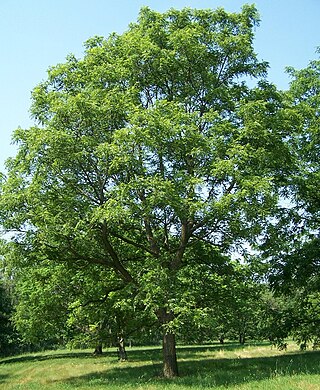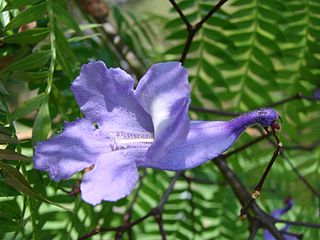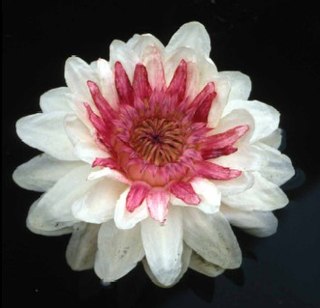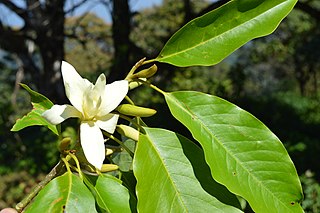
The Magnoliaceae are a flowering plant family, the magnolia family, in the order Magnoliales. It consists of two genera: Magnolia and Liriodendron.

Magnolia is a large genus of about 210 to 340 flowering plant species in the subfamily Magnolioideae of the family Magnoliaceae. The natural range of Magnolia species is disjunct, with a main center in east and southeast Asia and a secondary center in eastern North America, Central America, the West Indies, and some species in South America.

Vaccinium is a common and widespread genus of shrubs or dwarf shrubs in the heath family (Ericaceae). The fruits of many species are eaten by humans and some are of commercial importance, including the cranberry, blueberry, bilberry (whortleberry), lingonberry (cowberry), and huckleberry. Like many other ericaceous plants, they are generally restricted to acidic soils.

Walnut trees are any species of tree in the plant genus Juglans, the type genus of the family Juglandaceae, the seeds of which are referred to as walnuts. All species are deciduous trees, 10–40 metres (33–131 ft) tall, with pinnate leaves 200–900 millimetres (7.9–35.4 in), with 5–25 leaflets; the shoots have chambered pith, a character shared with the wingnuts (Pterocarya), but not the hickories (Carya) in the same family.

Ranunculaceae is a family of over 2,000 known species of flowering plants in 43 genera, distributed worldwide.

Dalbergia is a large genus of small to medium-size trees, shrubs and lianas in the pea family, Fabaceae, subfamily Faboideae. It was recently assigned to the informal monophyletic Dalbergia clade : the Dalbergieae. The genus has a wide distribution, native to the tropical regions of Central and South America, Africa, Madagascar and southern Asia.

Jacaranda is a genus of 49 species of flowering plants in the family Bignoniaceae, native to tropical and subtropical regions of the Americas while cultivated around the world. The generic name is also used as the common name.
Michelia is a historical genus of flowering plants belonging to the family Magnoliaceae. The genus included about 50 species of evergreen trees and shrubs, native to tropical and subtropical south and southeast Asia (Indomalaya), including southern China. Today it is regarded as a synonym and section of the genus Magnolia.

Magnolia officinalis is a species of Magnolia native to the mountains and valleys of China at altitudes of 300–1500 m.

The Antilocapridae are a family of ruminant artiodactyls endemic to North America. Their closest extant relatives are the giraffids. Only one species, the pronghorn, is living today; all other members of the family are extinct. The living pronghorn is a small ruminant mammal resembling an antelope.

Ormosia is a genus of legumes. 131 living species, mostly trees or large shrubs, are native to the tropical Americas, from southwestern Mexico to Bolivia and southern Brazil, to southern, southeastern, and eastern Asia, and to New Guinea and Queensland. Most are tropical, while some extend into temperate temperate regions of China. A few species are threatened by habitat destruction, while the Hainan ormosia is probably extinct already.

Swartzia is a genus of flowering plants in the family Fabaceae. It was named in honor of Swedish botanist Olof Swartz and contains about 200 species. Swartzia is restricted in its geographical distribution to the New World Tropics, where it occurs primarily in lowland rainforests, but also in savannas, pre-montane forests, and tropical dry forests. While it can be found throughout the wet lowlands from Mexico and the Caribbean islands to southern Brazil and Bolivia, Swartzia is most abundant and species-rich in Amazonia, where 10–20 species may co-occur at a single site. The species of Swartzia are mostly trees, ranging from small understory treelets to large canopy emergents. Some species, especially in savannas, are mult-stemmed shrubs.
Magnolia neillii is a species of plant in the family Magnoliaceae. It is endemic to Ecuador. Its natural habitat is subtropical or tropical moist lowland forests. If the Magnolia family is treated as consisting of a large number of smaller genera, then this species is placed in genus Talauma. In modern literature, it is customary to treat Magnolia as one large genus, and in that case, this species is treated as belonging to section Talauma in subgenus Magnolia.

The Flora of Colombia is characterized by over 32,000 species of green plants.
Magnolia poasana is a sub-tropical to tropical, subcanopy tree, growing in areas of montane rainforest. The names "Poas", and "poasana" originate from the Poás Volcano in Costa Rica where, along with Panama, they grow in the wild. First described by Henri François Pittier in 1910, it was later described and included in Magnolia by James Edgar Dandy (1927).

Prunus subg. Prunus is a subgenus of Prunus. This subgenus includes plums, apricots and bush cherries. Some species conventionally included in Prunus subg. Amygdalus are clustered with plum/apricot species according to molecular phylogenetic studies. Shi et al. (2013) has incorporated subg. Amygdalus into subg. Prunus, thereby including almonds and peaches in this subgenus. The species in this subgenus have solitary flowers or 2–3 in a fascicle.
Yingchengvirus is a genus of double stranded DNA viruses that infect haloarchaea. The genus was previously named Betasphaerolipovirus.

Magnolia nilagirica is a species of plant in the family Magnoliaceae. It is a tree that is threatened by habitat loss, endemic to the Western Ghats of India, and also Sri Lanka.

Allium is a genus of monocotyledonous flowering plants with hundreds of species, including the cultivated onion, garlic, scallion, shallot, leek, and chives. The generic name Allium is the Latin word for garlic, and the type species for the genus is Allium sativum which means "cultivated garlic".
Magnolia pedrazae is a species of flowering plant in the family Magnoliaceae. It is endemic to the Sierra Madre Oriental of eastern Mexico.















